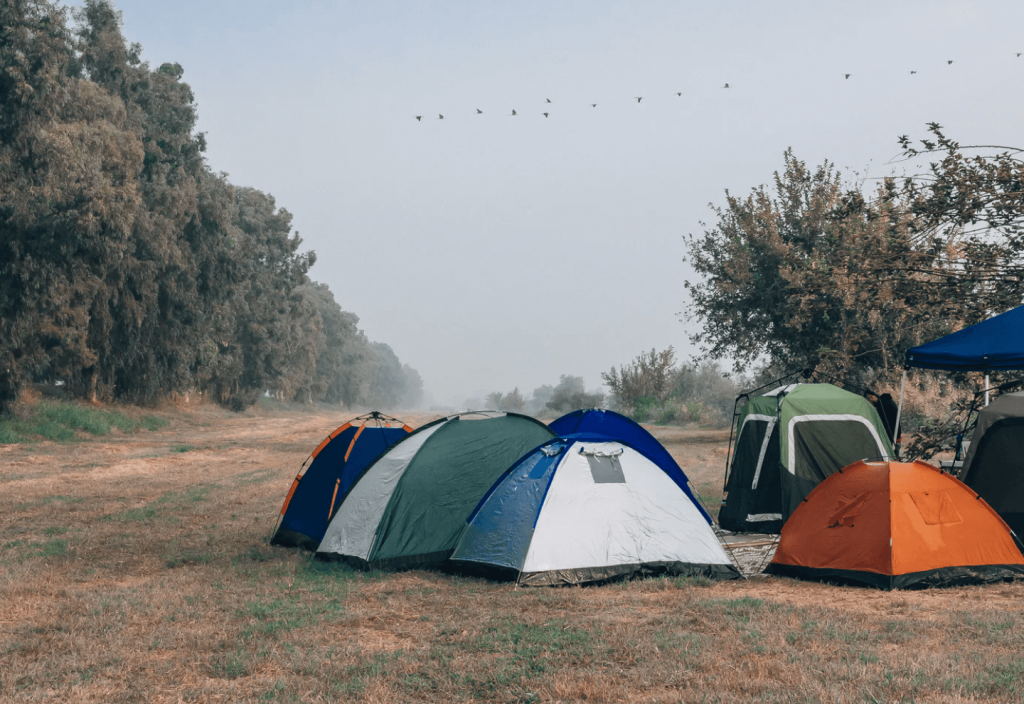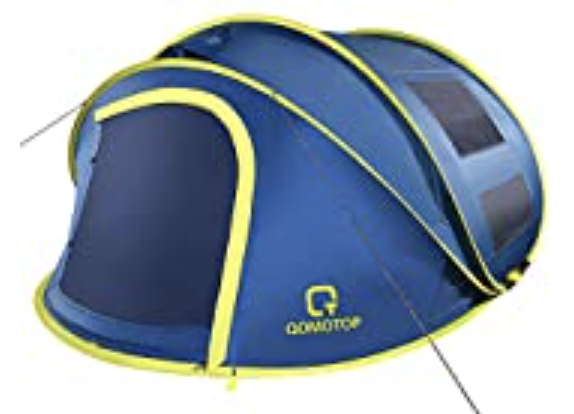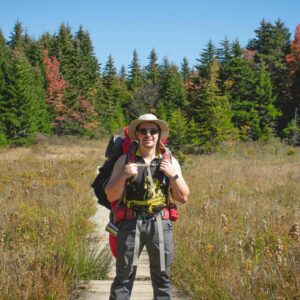
After extensive research, we found the REI Co-op Grand Hut 4 is the best 4-person tent. In the backpacking tents department, you’ll get the best bang for the buck with the Kelty Late Start 4. The Big Agnes Copper Spur HV UL 4 heads the list of premium backpacking tents.
The REI Co-op Grand Hut 4 is our winner for very good reasons. Simply, it delivers impeccable performance, advanced features and you can get it for a reasonable price.
It’s tall and spacious to provide comfort. In rainy conditions, it will stay dry while maintaining excellent air flow thanks to very effective high and low air vents.
Moreover, it’s lightweight and easy to pitch. Plenty of pockets and loops make it convenient to organize your stuff.
Some tents may outshine it in particular segments, but the Grand Hut 4 is on the winning end of the range in pretty much all categories. Which makes it the best overall.
The Kelty Late Start 4 wins the race among the backpacking tents. It comes with lots of great features and it is affordable. With a super-quick setup, compact package, lightweight, and excellent weather resistance, it provides all essential qualities for a backpacking tent.
If you prefer exceptional performance combined with advanced features you can’t go wrong with the NEMO Wagontop 4 for camping and the Big Agnes Copper Spur HV UL 4 for backpacking.
We have gone through thick and thin to create the list of best 4-person tents to suit everybody’s needs.
So, let’s cut to the chase.
Best 4 Person Tents – Top Recommendations
Best overall: REI Co-op Grand Hut 4
Best value for money camping tent: Quechua Arpenaz 4.1
Best value for money backpacking tent: Kelty Late Start 4
Best budget option: Coleman Sundome Tent
Best instant 4-person tent: OT Qomotop 4 Person Pop Up Tent
Best premium camping tent: NEMO Wagontop 4
Best premium backpacking tent: Big Agnes Copper Spur HV UL 4
Best extra tall 4-person tent: Eureka Jade Canyon 4 Tent
Best basic and affordable 4-person camping tents:
- Quechua Arpenaz 4.1 – best value for money
- OT Qomotop 4 Person Pop Up Tent – 10 second set up
- Coleman Sundome Tent – budget option, but very reliable
- Coleman Carlsbad Dome Tent – roomy tent with a screen room and partial blackout fabric
Best premium 4-person camping tents:
- Eureka Jade Canyon 4-Person Tent – very tall cabin tent
- REI Co-op Grand Hut 4 Tent – lightweight, high-quality tent
- NEMO Wagontop 4 Tent – unique design, very stylish
Best 4-person backpacking tents:
- REI Co-op Trail Hut 4 – airy and versatile tent
- Kelty Late Start 4 – super-fast setup
- Marmot Tungsten 4 – roomy and highly waterproof
- Big Agnes Copper Spur HV UL 4 – top-notch tent, ultra lightweight
- MSR Elixir 4 Backpacking Tent – sturdy and durable
We know this is a big decision for you, so we’ve included a comprehensive buyer’s guide. It also includes the criteria we used to select tents on this list.
Coleman Sundome Tent
- Space & comfort (30%) – 6/10
- Weather resistance (25%) – 7/10
- Build quality and durability (15%) – 7/10
- Ease of setup (10%) – 8/10
- Weight & Portability (10%) – 9/10
- Company history and reputation (10%) – 8/10
Best for: campers who want a basic and affordable tent that gets the job done; $
You’re ready to embrace the great outdoors, but you don’t want to break the bank from the very beginning? Or you’re just an occasional summer camper, so you see no reason to spend a fortune on your gear?
The Coleman Sundome Tent might be the best choice for you. It’s a great entry-level tent that will perform just fine. Just as long as you don’t push it to the limit.
This tent is all about simplicity and functionality. The setup is easy and quick. It takes up to 10 minutes even for inexperienced campers.
Measuring 9 by 7 inches it’s a roomy model for 2 or 3 campers. It can fit a queen-size air mattress with enough spare room for gear and stuff. So, you should always downsize the rated capacity. If you want comfort, that is.
A peak height of 4’11” is good enough to sit in the tent comfortably. It’s not a full-standing height, but you won’t feel claustrophobic and too confined.
When it gets warmer you’ll be very happy inside this tent. Large mesh windows and a ground vent provide great airflow to stay cool. Also, ventilation is the best way to prevent condensation.
So, on hot days and cool nights the tent stays fresh and dry.
Should the rain come, it offers some basic protection. The tent includes a rainfly. It covers the roof and walls roughly halfway down, so it’s not a full-coverage fly. However, all Coleman tents are tested to withstand rain and wind.
True, Coleman doesn’t provide info on waterproof rating, but a vast number of users claimed to stay dry in light to moderate rain.
From the technical point of view, they’ve done it all. Coated fabric, welded corners, inverted seams, and thicker floor. That’s pretty much all it takes to make the tent waterproof.
Mind you, even the name suggests it’s a tent for warmer weather. So, don’t expect it to handle heavy rain and downpours.
Even without rain, it’s not the best tent for colder weather. With so much mesh and vents it can’t hold the warm air inside the tent.
Pros:
- Budget-friendly
- Excellent choice for new campers
- Great ventilation
- Easy setup
- Can handle winds up to 35 mph and light to moderate rain
- Power access point
Cons:
- Won’t perform in colder weather. Too much airflow and only a modest weather protection
OT QOMOTOP 4 Person Pop up Tent

- Space & comfort (30%) – 7/10
- Weather resistance (25%) – 6/10
- Build quality and durability (15%) – 6/10
- Ease of setup (10%) – 9/10
- Weight & Portability (10%) – 8/10
- Company history and reputation (10%) – 6/10
Best for: campers or festival-goers who want super-fast setup; $$
If you hate wrestling your tent in an attempt to set it up, you can leave this problem behind. OT QOMOTOP 4 Person Pop up Tent can be erected in only 10 seconds!
Yes, you heard it right. With pre-assembled poles and pop-up technology, the basic setup can be done in a matter of seconds. You’ll still need to stake it down which will take a couple of minutes. But, this is as quick and easy as it gets.
Taking it down might be a bit challenging. But, if you follow the instructions or check out some setup/takedown videos, it should take around 2 minutes to get it done.
The tent is lightweight as well. At 9.7 lb, it’s not a great effort to bring it to the camping site. But note, it’s not a backpacking tent. It’s a bit heavy for backpacking and the carry bag is bulky (39” x 39” x 2”).
The floor plan measures 9 by 7.5 inches. Thanks to its cabin-like shape, it’s pretty roomy even though it’s not very tall. The peak height is 50 inches, which is just about enough to sit comfortably in the tent.
Two doors on the opposite sides of the tent are pretty large and convenient. The other two sides feature mesh windows to provide the view and airflow. Speaking of ventilation, there are two additional roof vents.
So, with so many openings, ventilation won’t be an issue in warmer weather. However, if you keep the doors and windows closed at night, you’ll basically stop the airflow. To avoid condensation issues, you will have to keep them at least partially open.
All windows can be zipped or unzipped inside the tent. It really helps to adjust the airflow without leaving the tent. Not to mention if it suddenly starts to rain.
On the downside, the fabric is quite thin. It lets a lot of light inside, so if you like to sleep late, pray for cloudy weather. The groundsheet is also thin, so I would recommend placing a tarp beneath the tent.
The tent is water-resistant with sealed seams. However, it’s a one-layer tent with no rainfly. It will probably handle some light rain, but the 800 mm waterproof rating means it can’t withstand long or heavy rain.
Pros:
- Super-quick setup
- Very roomy for 2 persons
- 2 large doors
- Mesh windows that can open/close from inside
- Lightweight for car camping (not light enough for backpacking though)
- E-port
Cons:
- Thin fabric, thin floor. Not ideal for heavy abuse
- Low waterproof rating (800 mm)
Eureka Jade Canyon 4 Tent
- Space & comfort (30%) – 9/10
- Weather resistance (25%) – 8/10
- Build quality and durability (15%) – 8/10
- Ease of setup (10%) – 7/10
- Weight & Portability (10%) – 7/10
- Company history and reputation (10%) – 8/10
Best for: campers who want a tall, tech-friendly, and waterproof tent; $$$
You enjoy camping but you can’t stand a leaky tent and hunching over all the time? The Eureka Jade Canyon 4 comes with media pockets, stands tall, and battles the weather like a champ.
This tent stands out for its exceptional height, but it’s a great product with a bunch of convenient features.
For starters, it’s roomy. While the base is not extremely large at 8 by 8 ft it’s the height and vertical walls that provide extra space. The peak height is 7 feet, but you can stand up in every corner of the tent. Unless you’re a tall NBA player.
The next thing you’ll notice is how airy the tent is. It has one large entryway and huge mesh windows on each side. And the roof is all mesh. Basically, with the rainfly off, it’s almost all mesh with just a little bit of fabric enclosing the openings.
There are a few more features to give the tent a glamping feel. 3 pockets and a gear loft are convenient to store your small items. A media pocket is touch-friendly, so you can use your tablet without getting it out of the pocket.
If you’re a night owl you’ll need a lantern to light your tent. This model features 2 reflective panels to enhance floor-level lighting up to three times. So, read a book or write down your camping impressions without straining your eyes.
If the weather takes a turn for the worse, don’t worry. The 2000 mm waterproof rating ensures the fabric can handle some heavy rain.
The rainfly covers the roof and extends over all 4 sides of the tent, especially above the entryway. Side rain can still reach the walls, but they are also waterproof and windows can be zipped.
Surprisingly, it can handle some winds as well. Cabin tents are not the best choice for windy conditions due to their shape. The height isn’t helpful, either. But, high-quality materials with steel and aluminum poles provide a decent level of stability in stormy weather.
So, this tent excels in so many departments. At 18 pounds, it’s not even heavy considering the size. And it packs pretty small (27” x 9”) to fit into your car easier.
However, there’s always room for improvement. The floor isn’t very thick, so using a ground tarp might be a good idea to make it last longer.
While this model offers a lot for the price, Eureka has a very similar budget option for those who want to save a few bucks. It’s the Eureka Copper Canyon 4 tent with less weather protection.
Pros:
- Spacious with nearly vertical walls
- Ample headroom – peak height 7 ft
- Highly waterproof
- Touch-friendly pockets for smartphone or tablet
- Steel and aluminum poles create a strong and sturdy structure
- Light-reflecting panels to enhance night light
- Very large windows and mesh roof for great airflow
Cons:
- The floor is not very thick
Quechua Arpenaz Camping Tent
- Space & comfort (30%) – 9/10
- Weather resistance (25%) – 8/10
- Build quality and durability (15%) – 7/10
- Ease of setup (10%) – 7/10
- Weight & Portability (10%) – 7/10
- Company history and reputation (10%) – 7/10
Best for: campers who want a comfortable tent with separate sleeping and living areas; $$
Is it possible to get a large, comfy, and reliable, 2-room tent without splashing the money? Sure, the Quechua Arpenaz Camping Tent proves it.
It’s huge and tall so the space will never be a problem in this tent. An inner tent makes a sleeping area with dimensions of 94.5” x 82.7”. It’s a bit tight for 4 persons, but 2 or 3 campers can have a luxurious bedroom.
The outer flysheet blocks the bedroom completely and creates a roomy living area (approximately 55 sq ft).
How about a standing height throughout the tent? The peak height is 74” and 71” for the living room and the bedroom, respectively. A tunnel shape provides plenty of space with almost vertical walls.
Your only problem with the space will be how to use it. You can easily fit a table and chairs into the living area for starters. And there will be a lot of spare room for your stuff and gear.
This home-away-from-home provides exceptional comfort. And it performs regardless of the weather. All Quechua tents are tested to withstand rain and winds.
The Quechua Arpenaz has an impressive waterproof rating of 2000 mm for the rainfly and the inner tent. A sturdy polyethylene floor has a 5000 mm rating! So, the tent should stay completely dry in some heavy rain and downpours.
Truth be told, a couple of users have reported some raindrops entering the living area through the roof vents. On the other hand, dozens of users have raved about staying bone dry in torrential rain and winds.
So, the tent is obviously waterproof. Still, a perfect combination of rain and the wind from the right direction can blow a few drops inside the tent.
The setup is fairly easy. It’s not the fastest, but the color-coded poles and sleeves make it easy. It takes around 15 minutes to fully set it up.
At 21.6 pounds it’s not the lightest tent out there. But, for a car camping tent, it’s a decent weight. Not too light, but not too heavy, either.
A rectangular carry case is pretty compact with dimensions of 23.6” x 9.4” x 9.4”. It takes some practicing to pack the tent back into the case, though.
Overall, it’s a super-comfortable and reliable tent that offers great value for money.
Pros:
- Very roomy
- Standing height throughout the tent
- Excellent waterproof rating
- Very stable and comfortable in winds up to 30 mph
- Fabric filters UV rays (UPF 30)
- Easy to pitch with color-coded poles and sleeves
Cons:
- The wind can blow some rain into the tent through the roof vents
Coleman Carlsbad 4-Person Dome Tent
- Space & comfort (30%) – 8/10
- Weather resistance (25%) – 8/10
- Build quality and durability (15%) – 8/10
- Ease of setup (10%) – 8/10
- Weight & Portability (10%) – 8/10
- Company history and reputation (10%) – 8/10
Best for: campers or families who like to sleep in; $$
If you like to wake up on your own terms, you’ll love the Coleman Carlsbad 4-Person Dome Tent. The morning sun will not be your enemy anymore. The patented Dark Room technology allegedly blocks 90% of sunlight to allow you to sleep longer.
I am not sure about the number, but the tent is dark enough to let you sleep even in the daytime. The bottom part of the tent features regular, no-blackout fabric, so it’s not pitch black inside.
This feature comes with another great benefit – it reduces the heat as well. For summer camping, it’s a real game-changer. A darker and fresher tent will allow you to preserve more energy for any planned activities.
Apart from darkroom fabric, this model offers a lot of space. While the size of the sleeping area (9 by 7 ft) is not extraordinary by any means, an addition of a screen room provides ample space.
Note that the screen room is not covered by the rainfly, so it’s exposed to rain. There’s a drain on the floor to prevent collecting rainwater. Unfortunately, you can’t leave your stuff in the screen room when it’s raining.
Coleman doesn’t provide waterproof ratings for their tents. But, according to a vast number of users, it can handle light and moderate rain staying bone dry. Well, apart from the screen room.
The rainfly isn’t full coverage, but it extends down the walls creating small awnings. It’s not a useful space, but it will allow you to keep the windows open when it rains.
Also, it can handle winds up to 35 mph.
It’s fair to say that this tent is wonderful for nice weather. While it can handle some inclement weather, it’s not designed for it.
The screen room becomes useless in the rain even as a storage space. The sleeping area is well protected, but with all the gear and occupants it becomes a bit crammed.
The tent weight is not that important for car camping, but still, the lighter the better. This model is pretty light at 10 pounds. It also comes with a convenient, expandable carry case for easy packing and transport.
Pros:
- Dark Room technology keeps the tent darker and cooler
- Quick and easy setup – about 10 minutes
- Floored screen room for lounging
- Waterproof in light and moderate rain
- Lightweight (for a car camping tent)
- Power cord port
Cons:
- No rain protection for screen room
REI Co-op Grand Hut 4
- Space & comfort (30%) – 8/10
- Weather resistance (25%) – 7/10
- Build quality and durability (15%) – 8/10
- Ease of setup (10%) – 7/10
- Weight & Portability (10%) – 8/10
- Company history and reputation (10%) – 9/10
Best for: campers who want a tall tent for shorter camping trips; $$$
If you like tents with a standing height and prefer shorter camping trips, this might be the best tent for you. Why is it best for shorter trips? The floor area is somewhat small so there’s not much room for gear.
Don’t get me wrong here, it’s not a small tent. Floor dimensions of 100” x 86” provide a 60 sq ft area which is just a little bit less than most of the competition. But, with nearly vertical walls and a peak height of 75”, it’s very roomy unless you have a ton of stuff.
Also, you have two vestibules at the opposite ends of the tent. They are not large and you can’t stand up in them because vestibules walls are sloped. Still, it’s another 35 sq ft of area to store some of your gear and your muddy boots.
You can turn both vestibule doors into awnings with a couple of poles and guylines.
Since there are 2 vestibules, there are 2 doors as well. 2 entryways provide extra comfort in many ways.
If one door faces the sun, you can close it and keep the opposite entrance open. Double doors provide better airflow. And of course, getting in and out is easier without stepping over your gear or roommates.
The upper part of the tent is all mesh, roof included. So, you’ll have plenty of airflow as well as great views. The bottom part of the tent is made of 75-denier ripstop polyester. In simple English, it’s a strong and durable fabric.
Should the weather get ugly, a rainfly will fully cover the tent to keep you dry and happy. The combination of high and low vents will produce a “chimney effect”. It means that the airflow will be sufficient even with the rainfly on.
The tent withstands the rain very well. Many users have reported handling heavy rain without letting a single drop getting inside the tent.
The only downside of this tent is one of its strengths – the height. Being so tall, it’s not great in heavy winds. Having said that, it has a solid aluminum construction and it won’t bend until the wind gets really strong.
Pros:
- Tall ceiling (75 inches)
- Durable, high-quality fabric
- Full-coverage rainfly
- Waterproof
- High and low vents on the fly for better air circulation
- Lightweight for car camping (12.1 lbs.)
- Multiple pockets and loops for gear or lights
Cons:
- It struggles in stronger winds
NEMO Wagontop 4 Tent
- Space & comfort (30%) – 8/10
- Weather resistance (25%) – 7/10
- Build quality and durability (15%) – 8/10
- Ease of setup (10%) – 8/10
- Weight & Portability (10%) – 7/10
- Company history and reputation (10%) – 8/10
Best for: campers who want a stylish and comfortable tent; $$$
If you want a luxurious camping experience in a beautiful tent, look no further. The NEMO Wagontop 4 Tent is as pretty as it is functional. This tent won’t go unnoticed, I can promise you that.
It’s a bit pricey but it offers a lot in return. To begin with, it’s very roomy. The main room is just short of 70 sq ft plus you get a vestibule area of 27 sq ft. Unique design and vertical walls will only enhance the feel of spaciousness.
It can fit a queen-size airbed easily, and there will be a lot of spare room. It’s possible to fit 4 sleeping pads in the tent, but I would downsize it to 2 persons, maybe 3. This tent is not meant to be an overnight shelter, but a classy, livable cabin.
It’s not only large, but it’s also tall. The peak height of 6’ 5” will allow ample headspace for all occupants. Wide and stylish mesh windows provide great, almost panoramic views.
There are multiple pockets and loops around the tent. So, you can store your items or hang a lantern.
Somewhat surprisingly, it’s a single-wall construction. Typically, tents of this size and class have 2 layers, the inner tent, and the rainfly. But if you’re worried that the lack of the rainfly would compromise the performance, you shouldn’t be.
The waterproof fabric will keep the rain away, even with no rainfly. While the 1500 mm waterproof rating isn’t that impressive, user experiences confirm excellent waterproofness.
Truth be told, several users have complained about leaky windows. Windows can’t be zipped, they have buckles instead. Apparently, it was a weak spot to allow some water to enter the tent.
However, the 2020 edition came with some improvements, windows included. A couple of users have reported staying completely dry in torrential rain. So, it looks like they have solved the problem.
It’s worth mentioning the floor is also made of thicker, 300-denier polyester to make it more durable.
In my opinion, this tent has no shortcomings, but there’s always some room for improvement. Single-wall tents tend to have some condensation issues. If it rains and you close all openings, you’ll barely get any airflow. Ground vents are a missing piece to deal with this issue.
That being said, the mesh doors and windows make it well-ventilated in nice weather.
Pros:
- Stylish design
- Spacious interior
- Standing height throughout the tent
- Plenty of storage pockets and loops
- Strong and sturdy floor
- Waterproof
Cons:
- Poor ventilation when you close the openings in rainy conditions
REI Co-op Trail Hut 4
- Space & comfort (20%) – 7/10
- Weather resistance (20%) – 7/10
- Build quality and durability (20%) – 7/10
- Ease of setup (20%) – 9/10
- Weight & Portability (10%) – 6/10
- Company history and reputation (10%) – 9/10
Best for: backpackers who want airy tent that sets up quick and easy; $$
You want a well-ventilated tent that sets up in no time? The REI Co-op Trail Hut 4 might be the one for you. A plenty of mesh provides excellent airflow. It’s also one of the easiest tents to assemble.
The setup is intuitive and most parts are pre-attached. So, you can’t go wrong. Even kids manage to set it up easily. One user believed he could literally do it blindfolded. I don’t know about that, but you get the picture of how easy it is.
Easy setup also makes it a great choice for beginners. Or for parents with children making their first backpacking trips.
While it is billed as a backpacking tent, I’d say it’s a sort of cross-over. The weight of just above 8 pounds is on the heavier side for backpacking. So, it can be used as a car camping tent as well.
Floor dimensions of 90” x 88” offer enough room for 3 sleeping pads and spare room for some gear. What’s more, there are 2 vestibules providing additional room for your boots and backpacks.
The rainfly fully covers the tent and both vestibules. So, you don’t have to worry about side rain or your boots getting soaked in rain.
I love tents with 2 doors even though they add up some weight (more zippers). Two entrances are convenient especially when doubled with vestibules. In rainy conditions you can partially unzip one door to get more airflow.
The rainfly also has top vents, for air circulation in wet weather.
But the tent is highly waterproof. Similar to the NEMO Wagontop 4 Tent, it comes with a decent 1500 mm coating. But in the field, it exceeds the expectations.
REI claims that it was tested to withstand an 1800 mm water column and many users confirmed it in real life situations.
This tent is made of durable polyester. It comes with a footprint which is rare and a big plus if you ask me. The tent floor is the most vulnerable part of it due to direct contact with the ground. Another protective layer will most certainly extend the lifetime of the tent.
The greatest enemy of this tent is a strong wind. Some users have experienced the tent collapsing under the gusts of wind. REI recommends not to use it in winds stronger than 30 mph.
Pros:
- Super-easy and quick setup
- 2 vestibules for storing gear
- 2 doors
- Comes with a footprint
- Full-coverage rainfly
- Excellent ventilation – no condensation
Cons:
- A bit heavy (packed weight – 8 lbs. 1.6 oz.)
- Can’t handle stronger winds
Kelty Late Start 4 Person – 3 Season Backpacking Tent
- Space & comfort (20%) – 7/10
- Weather resistance (20%) – 7/10
- Build quality and durability (20%) – 7/10
- Ease of setup (20%) – 9/10
- Weight & Portability (10%) – 7/10
- Company history and reputation (10%) – 8/10
Best for: backpackers who want super-quick setup; $$
Whether you change your camping spot often, or you just hate pitching a traditional tent, a quick and easy setup can solve your problems. The Kelty Late Start 4 is probably the tent with the fastest setup apart from instant tents.
One person can set it up in 3 to 4 minutes, hence the name of the tent. Even if you’re running late, you can erect the tent in no time to get back on track.
It’s not a large tent, measuring 99” by 81” which gives you a 55 sq ft area. But, pre-bent poles create steeper walls, almost vertical at the bottom part of the tent. This provides additional space inside the tent. It has a single door and a vestibule in front of it.
The vestibule is not particularly large (9 sq ft)either, but it’s enough to leave your muddy boots and some gear out of the sleeping area.
Backpacking tents aren’t tall, but this one is among the tallest. A peak height is 56 inches, giving you ample headroom when sitting or changing clothes.
While the tent stands out for its speedy setup, it excels in other areas as well. For summer backpacking expeditions, you’ll hardly find a better-ventilated tent. Tent walls are made of no-see-um mesh, mesh, and more mesh.
I am not exaggerating it, it’s almost all mesh. There’s only a strip of polyester fabric at the bottom part of the tent. So, it’s as airy as it gets in dry weather.
Should the rain come, a full-coverage rainfly will keep the tent dry. All seams are sealed and a waterproof rating of 1800 mm is pretty good. It’s not enough for the monsoon season, but it should keep your tent dry in moderate and persistent rain.
However, there are no air vents on the rainfly. With only one door and no vents, there’s not much you can do to get some airflow with the rainfly on. While the tent may stay dry, you’ll have to wait for the rainfly to dry out or pack it wet in the mornings.
Speaking of packing, a carry case is compact and will fit into any larger backpack. The packed weight of 6 lbs. 14 oz. is on the upper limit for backpacking. Considering the size, I’d say it’s lightweight enough.
Pros:
- Lightning-fast setup
- Pre-bent poles for additional space
- Ample headroom (for a backpacking tent)
- Compact package ( 18” x 7.5” x 7.5”)
- Lots of mesh for the ventilation, views, and watching the skies
- Great user reviews
Cons:
- Poor ventilation with the rainfly on
Marmot Tungsten 4P Tent
- Space & comfort (20%) – 7/10
- Weather resistance (20%) – 8/10
- Build quality and durability (20%) – 7/10
- Ease of setup (20%) – 7/10
- Weight & Portability (10%) – 6/10
- Company history and reputation (10%) – 9/10
Best for: small families or backpackers who want roomy tent capable of handling the elements; $$$
If you’re looking for a weather-resistant and spacious backpacking tent, the Marmot Tungsten 4P won’t disappoint you.
Backpacking tents are never really large but even inches count for more comfort. This model is slightly taller than most of the competition with a peak height of 52”. But, it’s the Zone Pre-Bend system that provides more space.
While it sounds like a high-tech thing, it’s all about pre-bent poles. The bottom sections of poles are bent to create vertical walls at the bottom part of the tent. Therefore, you’ll have more room for sitting or to store your stuff.
2 doors and 2 vestibules provide additional conveniences. Entry/exit is easier with 2 doors on the opposite parts of the tent. Vestibules can be used to store your gear and adjust the airflow levels.
When the weather gets ugly, the tent shows its strength. First, the rainfly fully covers the tent. Both the rainfly and the wall fabric are waterproof with ratings of 1500 mm and 1800 mm respectively.
But, forget the numbers, a real-life experience matters more. Dozens of happy users rave about staying bone dry in storms and downpours. Also, I couldn’t find a single user report of even the smallest leakage.
So, this tent is waterproof, no doubt about it. Moreover, it handles some strong winds pretty well, too.
A tent floor is even more waterproofed as well as the footprint that comes with the tent. Weather-wise, they’ve got it all covered.
A setup is pretty easy with color-coded clips and poles. There are no sleeves, you attach the rainfly to the tent with simple clips. It’s a freestanding structure, but as always, it’s a good idea to stake it down anyway. You never know when the wind will start to blow.
On the downside, it’s a bit heavy for a backpacking tent. Weighing 8 lbs. 11 oz. (footprint included) it’s not that challenging for shorter hikes. But, for longer backcountry trips, it’s heavy. You can split it between 2 persons though.
It is not the most affordable model, but it lives up to its price tag. Beyond the roominess and weather-related performances, it offers lots of additional conveniences.
I have already mentioned 2 doors and vestibules. Then, you have plenty of pockets for your small items and 2 lamp pockets on the ceiling. High-quality zippers, plenty of mesh for ventilation and stargazing – it’s pretty much all you can ask for.
Pros:
- Pre-bent poles at the lower part of the tent provide vertical walls, thus more space
- Solid height for a backpacking tent (52”)
- Waterproof
- Footprint included
- High-quality zippers
- 4 wall and 2 ceiling pockets
Cons:
- It’s heavy
Big Agnes Copper Spur HV UL4 Backpacking Tent
- Space & comfort (20%) – 7/10
- Weather resistance (20%) – 7/10
- Build quality and durability (20%) – 9/10
- Ease of setup (20%) – 8/10
- Weight & Portability (10%) – 8/10
- Company history and reputation (10%) – 9/10
Best for: backpackers who don’t mind spending a lot to get a top-notch quality; $$$$
Your priority is to get the best quality even if it costs a lot? The Big Agnes Copper Spur HV UL4 will deliver. It’s a high-end tent that shines in every department.
To begin with, it’s super-easy to set it up or take it down. It’s intuitive and you can do it even without instructions.
The tent is spacious and livable. You’ll get a 57 sq ft floor area and smart design with pretty steep walls to increase the usable space. The height of 50 inches is also quite generous for a backpacking tent.
2 doors are always useful. Especially when they are doubled with multi-purpose vestibules. The Copper Spur vestibules add 14 sq ft in front of the entryways. You can store your boots and gear.
Doors on both vestibules can turn into awnings with a pair of poles and guylines.
When the weather gets ugly, this tent will protect you. While the 1200 mm rating doesn’t sound too impressive it will handle rain quite well. The secret lies in premium craftsmanship, materials, and coating.
Double rip-stop nylon, silicone and polyurethane coating, top-notch DAC aluminum poles, and stakes make all the difference. This tent can handle persistent rain and strong winds.
While it was designed with rain in mind, it’s still a 3-season tent. So, under heavy and persistent rain it will eventually start to leak.
You don’t have to worry about ventilation, either. Roughly, the bottom half of the tent is “normal” nylon fabric and the upper half is all mesh. In rainy conditions, fly vents and 2 adjustable vestibule doors will give you enough options to get a decent airflow.
It’s also a lightweight tent with a 5 lb 11 oz packed weight and 5 lb 4 oz trail weight.
Another cool feature is a fast-fly setup option that weighs only 4 pounds. It takes the footprint and the fly without the inner tent body. You need to purchase the footprint separately, though.
So, the Copper Spur performs great in any conditions apart from the winter. But, that’s not all. Very impressive attention to detail gets this tent to another level of comfort and convenience.
It comes with no less than 8 storage and 4 media pockets. There’s also a door pocket, to store the door when unzipped. Multiple loops allow you to hang gear lofts and lamps.
Zippers are smooth and reliable. There are also extra guyout points to strengthen the structure if there’s a storm approaching. Finally, reflective guylines and webbings make sure you’ll notice the tent in the darkness.
Is there anything they didn’t think of? I don’t think so. The Copper Spur is a compact tent packed with features. Exceptional materials and design provide premium quality, but also comes with premium pricing.
Pros:
- Lightweight at 5 lbs. 4 oz.
- Setup is a breeze
- 2 doors and 2 customizable vestibules
- Premium materials
- Abundance of storage pockets
- Silicone-coated fly and floor fabric
Cons:
- Expensive
MSR Elixir 4 Backpacking Tent
- Space & comfort (20%) – 7/10
- Weather resistance (20%) – 8/10
- Build quality and durability (20%) – 9/10
- Ease of setup (20%) – 7/10
- Weight & Portability (10%) – 6/10
- Company history and reputation (10%) – 9/10
Best for: backpackers who want durable and weatherproof tent; $$$
If you’re looking for a weather-resistant tent to serve you for years, the MSR Elixir 4 is one of the best choices. Maybe it lacks some advanced features, but it offers customary MSR high quality at a reasonable price.
Simply, it performs impeccably in all essential aspects. Let’s see.
The floor area of 54 sq ft is pretty much the common size for the class. But, two vestibules provide an additional 24 sq ft to make the tent roomy and comfortable.
A peak height of 48” is decent but not impressive. However, smart pole geometry provides ample headroom and more space overall.
So, it’s comfy. But, it stands out for its sturdiness and durability. It is so because of high-quality materials. Tent walls are made of 40D (Denier) ripstop nylon and 20D micro-mesh nylon. It means that the fabric is thick, strong, and tear-resistant.
The floor is 70D nylon and the fly is ripstop polyester. Maybe, I am getting too technical here, but I want to back up the statement about the tent’s durability and material quality.
Most commonly, tents in this class have 10 or 20D nylon walls and 40D floor. The higher the D-number, the stronger and tougher the material.
All fabric is coated with a waterproof coating from the inside and with silicon or water repellent from the outside. This allows the tent to be waterproof without compromising the tear strength.
The waterproof ratings of 1500 mm and 3000 mm for the fly and floor respectively provide excellent protection against rain.
So, you can rest assured the Elixir will stand strong and dry in stormy and wet weather.
However, there’s a trade-off. A higher Denier count means more strength but also more weight.
It’s very sturdy and reliable, while it is somewhat heavier (9 lbs 6 oz) than the best tents in the class. It’s better than the other way around.
Note that it comes with a footprint so it would be lighter without it. You can also split the weight between several people.
Even though it’s a performance-oriented tent, it comes with a couple of nice additional features.
There are 4 storage pockets plus a gear loft to store your small items. I have already mentioned the footprint. It will significantly increase the durability of the floor (which is already strong and durable).
Pros:
- Sturdy and durable
- Excellent weather protection
- High-quality materials and workmanship
- 2 doors and 2 vestibules
- Comes with a footprint
- Plenty of storage pockets plus a ceiling gear loft
Cons:
- A tad heavier
Buyer’s Guide – How to Choose the Best 4-Person Tent
4-Person tents come in a wide variety of styles and shapes. With so many options and different features, it is challenging to make the decision.
So, we come in with a comprehensive buyer’s guide to help you find the tent that suits you best.
Size & Capacity
While almost all tents have a declared capacity, in this case, 4-person, don’t count on it. Old camping wisdom has it that you should check the size to determine the capacity.
Manufacturers actually provide a maximum tent capacity with a very snug fit. It means that you can place that many sleeping pads next to each other with no spare room for your stuff.
So, it’s a general rule of thumb to downsize the number of occupants by at least 2. The larger the tent, the more subtracting you should do.
For backpacking tents, you can subtract 1 or 2 persons. Backpackers typically use less space for sleeping.
So, 4-person tents will typically accommodate 2 or 3 people tops. Here’s why.
Car Camping 4-Person Tent Size
4-person car camping tents usually offer around 65-70 sq ft of usable space. Some of them have screen rooms or vestibules but they are meant for storage or daytime activities.
This is enough space to put a queen-size air mattress with very little or no room left in the sleeping area. If you sleep in sleeping bags, you can fit in 3 sleeping pads with some spare room.
However, car campers usually want more comfort. As a general rule, 4-person camping tents are very comfortable for 2 people or 3 if there’s an additional room or protected vestibule.
Backpacking 4-Person Tent Size
Typically, backpacking 4-person tents come with a 55 to 60 sq ft floor area. They rarely have vertical walls or great height so it further limits the available space. So, most of them can’t fit a queen-size airbed, but 2 to 3 sleeping pads will fit in with some spare room.
Almost all backpacking tents have one or two vestibules to enhance comfort and provide additional space. However, they are usually rather small and you can use them to store your backpack and muddy boots.
Similar to car camping tents, 4-person backpacking tents can accommodate 2 to 3 people.
So, there you have it. Car camping tents are slightly larger but both types can take in the same number of occupants. Yes, backpackers are less “needy” regarding both space and comfort.
Setup
A quick and easy setup is not imperative, but it is convenient. Especially if there’s a storm approaching.
Backpackers and hikers also appreciate a quick setup more than typical car campers. When you’re on the move regularly you value each minute of spare time.
Height
The height of 4-person tents varies wildly depending on the style and intended purpose. Once again, a major division is between camping and backpacking tents.
4-Person Camping Tents
Car camping tents of any size focus more on comfort. Being able to stand up or walk inside the tent makes a lot of difference. From easy clothes changing to a home-like feel in the tent.
Therefore, many camping tents provide a full standing height or close to it. Still, they can fall anywhere between 50 and 80 inches or even more.
Depending on your camping preferences, make sure to check out the height to get the best out of your camping experience.
4-Person Backpacking Tents
As for the backpacking tents, they are never very tall. Simply, the focus is on lightweight and mobility. The larger and taller the tent, the heavier and bulkier it gets.
Backpacking tents tend to offer a height that provides ample headspace in a sitting position and no more. Needless to say, these rules apply regardless of tent capacity.
We are talking about a height of around 50 inches.
Backpacking tents are also shorter to provide better stability in windy conditions. Just think about it: if the wind collapses the tent car campers can simply walk to their car and drive away. A collapsed tent in the backcountry? Hmm, it can get pretty ugly.
One more: the smaller the volume of the tent, the easier it gets to keep the warmth in colder weather.
So, you don’t need a tall tent for backpacking. Still, a few extra inches of headspace are convenient as long as it doesn’t affect stability.
Shape
Although there are a variety of styles and some crossovers, the most typical categorization divides tents into 3 groups: cabin, tunnel, and dome tents.
The best choice depends on your camping preferences. Here’s what you will get from different tent styles.
4-Person Cabin Tents
4-person cabin tents are typically intended for car camping trips. They focus on comfort and livability. Basically, the idea is to have a home-away-from-home or a portable cabin in the woods.
To provide such comfort they have nearly vertical walls and tall ceilings. Also, they are designed for nicer weather. Typically they have large doors, mesh windows, and often a mesh roof for stargazing.
Of course, the mesh is mostly there to keep the bugs at bay and provide airflow and views.
Cabin tents offer a lot of versatility with screened areas, porches, room dividers, and other convenient features. Often, they come with separated living and sleeping areas, although it is more common in larger cabin tents.
The size and the height of cabin tents compromise weather protection and stability to a certain degree. The taller the tent, the more unstable it gets. Also, more often than not, they don’t have a full-coverage rainfly.
It’s another trade-off to make them more affordable and not extremely heavy and bulky.
Even without the rainfly, cabin tents are pretty heavy. They are meant for car camping so it’s not an issue.
Overall, look for a cabin-style tent if you prefer summer car camping trips.
4-Person Tunnel Tents
Tunnel tents are suitable for various purposes. More often they are designed for car camping trips, but you’ll find plenty of tunnel-shaped hiking and even backpacking tents.
Tunnel tents usually provide better protection against the elements compared to cabin tents. A tunnel-like shape is more aerodynamic so it can handle winds. Rain Flies are typically larger, covering most of the tent or all of it.
Typically, car camping or family-oriented tunnel tents are more popular in wetter climates.
They can also provide the same level of comfort as cabin tents. Tunnel shape allows tall constructions with vertical walls. So, most of the space is useful.
There’s a trade-off, though. With increased height comes the decreased stability.
Backpacking tunnel tents are shorter to shave off the weight and improve the strength of the structure.
As for backpacking trips, tunnel tents provide more room but less stability than dome-style backpacking tents.
4-Person Dome Tents
Dome shape is probably the most common among the tents. Dome tents have 2 or 3 flexible poles that cross over at the top of the tent to create a dome-like structure.
Their design allows them to be pretty stable in windy conditions. On the downside, sloped walls limit the space in the tent, especially headroom.
There are 4-person dome tents designed for both car camping and backpacking trips. Commonly, dome tents are lightweight and easy to pitch.
So, if you’re a car camper who likes quick trips and occasional short hikes, a dome tent may fit your needs well. It’s also a great choice for festivals.
Dome tents are the most common among backpacking tents. They can be very lightweight and super sturdy in adverse weather conditions.
Weight and Portability
I have already mentioned the weight in the “Shape” section. 4-person tents can vary a lot when it comes to weight, but it’s more important to pay attention to design.
For 4-person car camping tents, the weight is not an essential feature. Nevertheless, check it out. I would focus more on portability or a carry case.
Yes, you’ll drive to the camping site, but some car camping tents are very bulky. You might wish for a bigger car if a carry case is bulky or too long.
As for 4-person or any other size backpacking tents, the weight is of utmost importance. Every ounce counts. It’s an adage that always echoes on backpacking trips.
As a general rule of thumb, the weight of the backpacking tent should be under 2 pounds per person. Which gives us the upper limit of 8 pounds for a 4-person tent.
However, even slightly heavier tents are okay if you can split the weight between several people. And a 5-pound tent is heavy if you can’t.
Besides the weight, check out the size of the carry bag. Does it fit into your backpack? Some carry cases come with backpack straps. If so, you can conveniently attach it to the backpack.
Number of Doors
The number of entryways is not always essential, but it’s worth mentioning.
4-person camping tents can accommodate 2 to 3 persons, so it’s not a crowd. Still, it’s convenient to have 2 doors. Think of night toilet breaks. Or having 2 people sleeping while you’re awake and want to get out of the tent.
In backpacking tents, it’s even more noticeable. These tents are smaller, shorter, and it can be a real bother to roll over your mates to get out of the tent.
Materials
Materials quality largely determines the overall quality of the tent. So, regardless of the size and shape, it’s a consideration you should never skip.
When we talk about tent materials, we relate to fabric and poles.
The tent fabric determines how durable, waterproof, and breathable the tent will be.
Common tent fabrics are polyester, canvas, and nylon. It’s no different for 4-person tents.
Nylon is slightly stronger and lighter than polyester with similar properties. It is more expensive, though.
Typically, budget tents and car camping tents feature polyester being the most affordable kind.
Nylon is predominantly used to manufacture backpacking tents because it is the lightest material.
While these materials have differences, the craftsmanship and weaving techniques are more important than the type of fabric.
To choose the best fabric, check out user reviews, and read the labels. Many tents provide info on D (Denier) value, which designates the density of the material. The higher the number, the stronger the fabric.
Also, look for ripstop fabric. It means that the manufacturer has used special techniques to make the fabric more tear-resistant.
Poles can be made of steel, fiberglass, aluminum, and some advanced (read expensive and not very common) materials.
Steel poles are very strong but very heavy as well. They are not flexible and can corrode.
Fiberglass poles are the most common ones. They are affordable and relatively lightweight.
Not as strong as aluminum or steel poles, but they offer a solid quality for the price. They tend to break when overloaded, especially in cold weather.
Aluminum poles are lightweight, strong, and flexible and you’ll hardly see them break. Under too much pressure, they bend instead of breaking. High-end tents often feature DAC aluminum poles. DAC is the world’s leading brand of aluminum poles.
Weather Protection
A tent that can withstand the elements will enhance your camping experience a lot. A leaky tent can make your trip quite miserable, especially if you’re a hiker or backpacker.
I’ve said that fabric determines how waterproof the tent will be. Strictly speaking, it’s the coating that makes the fabric waterproof.
Look for waterproof rating also called HH (hydrostatic head). This is a standard that quantifies the waterproofness of the fabric. It is measured in mm and shows the height of the water column the tent can hold before starting to leak.
It is generally accepted that the fabric should have a 1000 mm rating or more to be considered waterproof. Mind you, a common umbrella has a rating of 400, 500 mm, so you can get the picture.
At 2000 mm, the fabric can handle some heavy rain. 3000 mm or more should make the fabric capable of battling whatever you throw at it.
Still, don’t take these numbers for granted. All coatings deteriorate over time. Also, water can enter the tent through seams or through the floor regardless of the waterproof rating.
The floor should be thicker and more waterproof as it is more prone to wear and tear.
As for seams, they need to be sealed to prevent leaking. Taped, inverted, or welded seams – these are different but efficient techniques to seal seams.
Ventilation
You should also check out the airflow. It’s not just pleasant to feel the breeze in the tent. Good ventilation is necessary to avoid condensation.
User reviews are always useful but you can get a picture by yourself as well. The more mesh the tent has, the better the airflow. Also, look for ground vents for better high-low circulation.
A full-coverage rainfly can decrease ventilation significantly. So check out if there are vents on the fly. Also, there should be a gap between the fly and the inner tent to provide efficient air circulation.
Final Verdict
4-person tents are so different, it was quite a challenge to narrow the choices down.
Eventually, the REI Co-op Grand Hut 4 won the competition. It comes with a perfect blend of basic, advanced, and convenient features. And you won’t have to spend a fortune to get it.
It’s a beginner-friendly tent, but even the most experienced campers praise its performance and reliability.
The Kelty Late Start 4 on the other hand, won’t blow you away immediately. But, it’s so well-rounded that you’ll fall in love with it over and over again. It’s almost surprising it doesn’t cost more considering the performance.
But, each and every tent on our list has some great features to enhance your camping experience. So, think about your preferences, choose your tent and go camping.



















